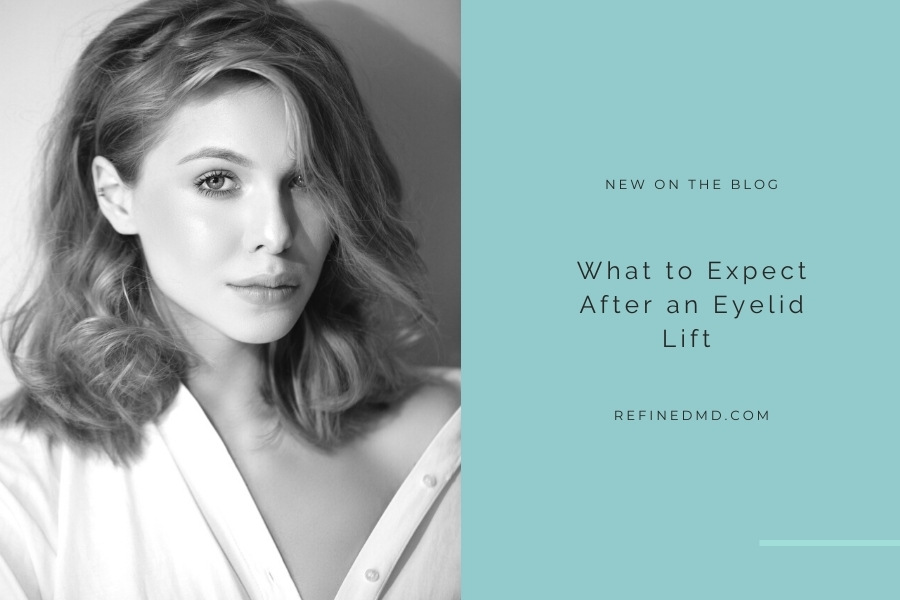
27 Jul What to Expect After an Eyelid Lift
Also known as blepharoplasty, there are two kinds of eyelid lifts: upper and lower. You might be a good candidate for one or the other, or both. At RefinedMD, triple board-certified Dr. Sudeep Roy specializes in facial cosmetic surgery, including blepharoplasty. Both surgeries are relatively quick with minor incisions required. They also heal surprisingly quickly given how vascular the region is, making them a popular add-on for other surgeries like a facelift, mini lift, or brow lift. However, some people are best suited for “just” a blepharoplasty, which makes sense considering that the area around the eyes is usually the first place to show signs of aging.
If you are considering a blepharoplasty, it’s important to know what to expect. The best way to do this is via a consultation with Dr. Sudeep Roy, but you can also do a little homework beforehand. Let’s take a look at both surgeries and exactly what you can expect after them. A lower blepharoplasty only addresses laxity (and often fat pockets) below the eyes and is usually the first place to show signs of aging on the face.
Lower Blepharoplasty 101
A lower bleph is very commonly paired with minor liposuction. This is because it is not just skin laxity that causes aging in this area, but uneven lost volume. “Bags” can be caused by a number of things, including lumpy fat pockets. If you need liposuction in this area, it is often included as part of your lower blepharoplasty. In some cases, you may also benefit from dermal fillers after fat pocket removal. It is important to have the right amount of volume in this area—not too much and not too little—to avoid both bags and a hollow look associated with looking older.
If you require fat removal, an incision is usually made inside the eyelid so you won’t see it. Many clients are surprised to find that such an incision is not painful or uncomfortable at all, but this is due to the amount of blood flow in the area. To remove excess skin, an incision is made right below the lower lash line. This area also heals quickly, but you will see some small crusting for 7 – 10 days after your surgery. In most cases, you will also have stitches and threading in this area. Some may dissolve on their own, but others may not and they will need to be removed by your surgeon in 7 – 10 days. Although such stitches and sutures are not painful, they can be annoying and many people want to avoid going out in public until they are removed.
Upper Blepharoplasty Expectations
Fat removal is usually not a part of an upper bleph. Instead, the main purpose of upper blepharoplasty is to address sagging, excess skin. Ptosis is the medical term for such sagging, and it can happen due to age/laxity as well as the muscles that open the upper eye simply getting worn out (either by age or trauma). Fortunately, the vast majority of clients do not actually need to have the levator muscle repaired. Instead, removing excess skin is enough to fix the sagging and give you back a bright, youthful appearance.
Incisions for an upper blepharoplasty are tucked into the natural creases of the eyelid. Similar to a lower bleph, stitches and sutures are common and will come out in 7 – 10 days. Again, these sutures are not painful and most people describe an upper or lower blepharoplasty as simply being a little sore. Eyes may be watery due to surgical trauma, but this typically subsides in a few days. In fact, most people can get back to working on laptops, being on their phone, and other daily tasks the day after a blepharoplasty. However, it is a good idea to let your eyes rest during this period, so be sure to follow your surgeon’s instructions.
Is Blepharoplasty for You?
Incisions that are healing and threads from sutures are usually resolved one week after your surgery. However, some people are prone to excessive bruising and swelling. This is also temporary, and can be helped with prescribed topical medications. In most cases, this bruising and swelling is what really keeps people from immediately getting back to their daily lives after a blepharoplasty, but don’t worry. These are also temporary side effects and will go away. Most bruising and swelling dissipate after two weeks, though some minor swelling and bruising may persist for up to four weeks.
In most cases, patients are confident to get back to life 1 – 2 weeks after their blepharoplasty surgery. It takes a small amount of time for big results that you’ll love. To find out more about upper and lower blepharoplasty, or to schedule a consultation with Dr. Roy, contact RefinedMD by chat, the online form, or calling the office.
